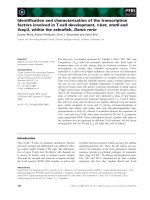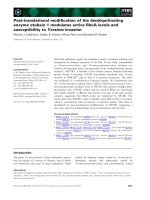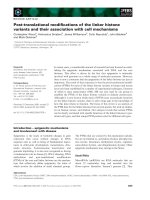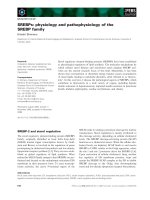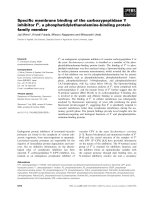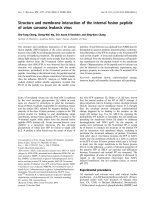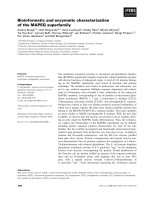báo cáo khoa học: "Metastatic collecting duct carcinoma of the kidney treated with sunitinib" potx
Bạn đang xem bản rút gọn của tài liệu. Xem và tải ngay bản đầy đủ của tài liệu tại đây (793.57 KB, 3 trang )
CAS E REP O R T Open Access
Metastatic collecting duct carcinoma of the
kidney treated with sunitinib
El Mehdi Tazi
1*
, Ismail Essadi
1
, Mohamed Fadl Tazi
2
, Youness Ahellal
2
, Hind M’rabti
1
and Hassan Errihani
1
Abstract
Collecting duct carcinoma (CDC) of the kidney is a rare and aggressive malignant tumor arising from the distal
collecting tubules which has been shown to have a poor response to several kinds of systemic therapy. We present a
case of metastatic CDC that responded favorably to a multiple tyrosine kinase inhibitor, sunitinib, achieving a partial
response in both lung and skeletal metastases. To our knowledge, this is the first report showing therapeutic activity
of sunitinib against CDC. Considering these findings, it would be worthwhile prospectively investigating the role of
multiple tyrosine kinase inhibitors, particularly sunitinib, in the management of metastatic CDC.
Keywords: Collecting duct carcinoma, Sunitinib, Metastasis
Introduction
Collecting duct carcinoma (CDC) of the kidney, also
known as Bellini duct carcinoma, is a rare variant of renal
cell carcinoma (RCC) arising from the epithelium of the
distal collecting ducts; it accounts for 2% of all RCCs [1].
Clinically, CDC is characterized by an extremely aggressive
phenotype, accompanying metastatic diseases at presenta-
tion in most reported cases; the prognosis ofCDC is there-
fore po or, with approxim ately 70% o f p atients dy ing of
disease progression within 2 years after diagnosis. In fact,
several systemic therapies, including cytokine therapy and
cytotoxic chemotherapy, have failed to achieve favorable
response to metastatic CDC except for very limited cases
[2-7]. Sunitinib is an orally available inhibitor of multiple
receptor tyrosine kinases, inc luding vascular en dothelial
growth factor receptor, platelet-derived growth factor
receptor, and others, with direct antitumor and antiangio-
genic activity. Based on impressive outcomes in several
clinical trials, sunitinib has been approved worldwide for
treatment of RCC patients with clear cell histology [8].
Furthermore, significant therapeutic activities of sunitinib
against non-clear cell RCCs, for example papillary and
chromophobe carcinomas, have also been reported in
recent studies [8,9]; however, it remains unknown whether
sunitinib has a therapeutic impact on CDC of the kidney.
Here, we report the first case of a patient with metastatic
CDC of the kidney who had a favorable response to suniti-
nib treatment.
Case report
A 47-year-old man with a 14.1 cm left renal mass
extending into the renal vein and metastases involving
the bilateral lungs and retroperitoneal lymph nodes
were referred to our institution.
* Correspondence:
1
Department of Medical Oncology, National Institute of Oncology, Rabat,
Morocco
Full list of author information is available at the end of the article
Figure 1 Hematoxylin and eosin staining of tissue sections
from the nephrectomy specimens demonstrating collecting
duct carcinoma (× 400).
Tazi et al. World Journal of Surgical Oncology 2011, 9:73
/>WORLD JOURNAL OF
SURGICAL ONCOLOGY
© 2011 Tazi et al; licensee BioMed Central Ltd. This is an Open Access article distributed under the terms of the Creative Commons
Attribution License ( .0), which permits unrestricted u se, distribution, and reproduction in
any medium, provided the original work i s properly cited.
Radical left nephrectomy combined with lymphadenect-
omy was performed. Pathological examination resulted in
diagnosis of this case as CDC with tubulopapillary archi-
tecture consisting of tumor cells with eosinophilic cyto-
plasm and high-grade nuclei (Figure 1). In addition,
immunohistochemical staining was characteristic of CDC;
that is, tumor ce lls were positive for Ulex Europaeus
agglutinin (Figure 2), cytokeratin 19, 34bE12, epithelial
membrane antigen and focally positive with vimentin [1].
Following radical nephrectomy, this case was treated with
sunitinib rather than systemic chemotherapy, considering
her poor performance status. After 4 courses of sunitinib
therapy with 37,5 mg daily sc hedule, metastases to the
lungs and left rib decreased by more than 30% compared
with findings before sunitinib treatment (Figure 3). Despite
the favorable effects of sunitinib on metastatic diseases,
pleural effusion appeared to be remarkable after the
administration of sunitinib; however, cytological examina-
tion showed no malignant cells in the pleural fluid. In
addition to pleural effusion, several adverse events asso-
ciated with sunitinib treatment, including appetite loss,
thrombocytopenias, and hypothyroidism, were observed.
Thereafter, disease progression occurred 10 months after
the initiation of sunitinib, and the patient died.
Discussion
BecauseCDCisanuncommonand aggressive disease
with extremely poor prognosis, accumulated information
Figure 2 Tumor showed positive staining for Ulex Europaeus
agglutinin.
Figure 3 Metastatic lesion to the right lung and left sixth rib before (A) and after (B) 4 courses of sunitinib treatment.
Tazi et al. World Journal of Surgical Oncology 2011, 9:73
/>Page 2 of 3
about CDC is very limited. Therefore, no established
therapy for CDC exists except for surgical resection of
localized diseases. To date, however, there have been 14
reported cases of metastatic CDC showing response to
system ic therapy, consisting 9, 2, 1, and 1 who were trea-
ted by gemcitabine plus cisp latin or c arboplatin, pacli-
taxel plus carboplatin, gemcitabine plus doxorubicin, and
interferon-a, respectively [2-7]. Considering these find-
ings in addition to the characteristics of CDC similar to
those of urot helial cancer, chemotherapy is the currently
favored approach for patients with metastatic CDC.
In the case presented, because of her poor perfor-
mance status associated with skeletal metastases, it was
judged to be difficult to perform intensive systemic che-
motherapy. Accordingly, she was treated with sunitinib,
which has been regarded a s one of the most powerful
age nts against metastatic RCC [8], and showed a partial
response to this drug. Recently, the favorable clinical
activity of sunitinib against non-clear cell carcinomas,
including papillary and c hromophobe carcinomas, has
also been reported [8,9]; however, t his is the first
reported case demonstrating a therapeutic response of
metastatic CDC to sunitinib. Furthermore, a recent
report presented a case of metastatic CDC showing
response to sorafenib [10].
Conclusion
Although the precise molecular mechanism involved in
the antitumor activity of multiple tyrosine kinase inhibi-
tors against CDC remains largely unknown, these find-
ings suggest that the efficacy of these agents, for
example sunitinib and sorafenib, against metastatic CDC
needs to be prospectively evaluated.
Consent
Written informed consent was obtained from the patient
for publication of this case report and accompanying
images. A copy of the written consent is available for
review by the Editor-in-Chief of this journal.
Author details
1
Department of Medical Oncology, National Institute of Oncology, Rabat,
Morocco.
2
Department of Urology, CHU Hassan II, Fez, Morocco.
Authors’ contributions
EMT, IE, MFT and YA analyzed, interpreted the patient data regarding its
oncological features, and has been involved in drafting the manuscript; HM
and HE has given final approval of the version to be published. All authors
read and approved the final manuscript.
Competing interests
The authors declare that they have no competing interests.
Received: 4 January 2011 Accepted: 13 July 2011
Published: 13 July 2011
References
1. Srigley JR, Eble JN: Collecting duct carcinoma of kidney. Semin Diagn
Pathol 1998, 15:54-67.
2. Gollob JA, Upton MP, DeWolf WC, Atkins MB: Long-term remission in a
patient with metastatic collecting duct carcinoma treated with taxol/
carboplatin and surgery. Urology 2001, 58:1058.
3. Milowsky MI, Rosmarin A, Tickoo SK, Papanicolaou N, Nanus DM: Active
chemotherapy for collecting duct carcinoma of the kidney: a case report
and review of the literature. Cancer 2002, 94:111-116.
4. Peyromaure M, Thiounn N, Scotté F, Vieillefond A, Debré B, Oudard S:
Collecting duct carcinoma of the kidney: a clinicopathological study of 9
cases. J Urol 2003, 170:1138-1140.
5. Tokuda N, Naito S, Matsuzaki O, Nagashima Y, Ozono S, Igarashi T:
Collecting duct (Bellini duct) renal cell carcinoma: a nationwide survey
in Japan. J Urol 2006, 176:40-43.
6. Oudard S, Banu E, Vieillefond A, Fournier L, Medioni J, Banu A, Duclos B,
Rolland F, Escudier B, Arekelyan N, Culine S: Prospective multicenter phase
II study of gemcitabine plus platinum salt for metastatic collecting duct
carcinoma: results of a GETUG (Groupe d’Etudes des Tumeurs Uro-
Génitales) study. J Urol 2007, 177:1698-1702.
7. Chao D, Zisman A, Pantuck AJ: Collecting duct renal cell carcinoma:
clinical study of a rare tumor. J Urol 2002, 167:71-74.
8. Rini BI, Flaherty K: Clinical effect and future considerations for
molecularly-targeted therapy in renal cell carcinoma. Urol Oncol 2008,
26:543-549.
9. Choueiri TK, Plantade A, Elson P, Negrier S, Ravaud A, Oudard S, Zhou M,
Rini BI, Bukowski RM, Escudier B: Efficacy of sunitinib and sorafenib in
metastatic papillary and chromophobe renal cell carcinoma. J Clin Oncol
2008, 26:127-131.
10. Ansari J, Fatima A, Chaudhri S, Bhatt RI, Wallace M, James ND: Sorafenib
induces therapeutic response in a patient with metastatic collecting
duct carcinoma of kidney. Onkologie 2009, 32:44-46.
doi:10.1186/1477-7819-9-73
Cite this article as: Tazi et al.: Metastatic collecting duct carcinoma of
the kidney treated with sunitinib. World Journal of Surgical Oncology 2011
9:73.
Submit your next manuscript to BioMed Central
and take full advantage of:
• Convenient online submission
• Thorough peer review
• No space constraints or color figure charges
• Immediate publication on acceptance
• Inclusion in PubMed, CAS, Scopus and Google Scholar
• Research which is freely available for redistribution
Submit your manuscript at
www.biomedcentral.com/submit
Tazi et al. World Journal of Surgical Oncology 2011, 9:73
/>Page 3 of 3

